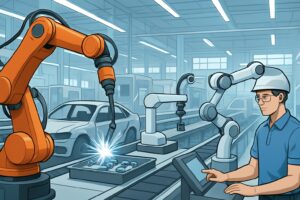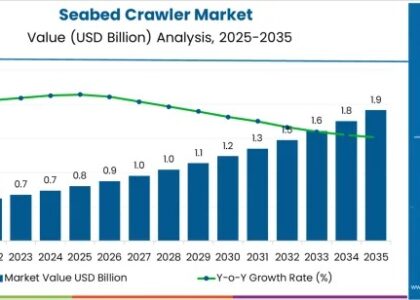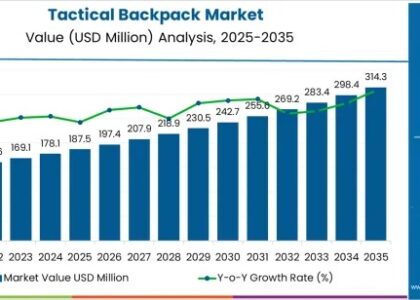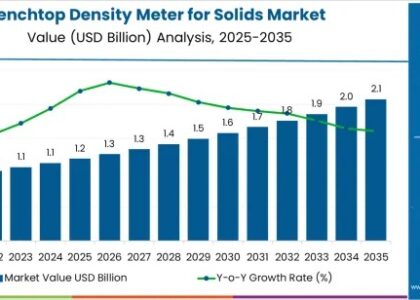
The industrial robot market is set for strong growth from 2025 to 2035, driven by rising automation needs, increasing labor costs, and demand for high-precision manufacturing. Widely used in industries such as automotive, electronics, metals, plastics, and food & beverage, robots perform key tasks like welding, assembly, and material handling. The market, starting at USD 7.1 billion, is being propelled by advancements in AI-based control systems, smart sensors, and cloud-based monitoring—enabling higher efficiency, real-time insights, and smarter factory operations.
The global industrial robot market is expected to witness substantial growth in the coming years, driven by technological advancements in AI and machine learning, increasing labor costs, and rising emphasis on safety and operational efficiency. With automation no longer a luxury but a necessity, manufacturers are actively investing in robotic systems that can work alongside humans, adapt to dynamic tasks, and reduce operational downtime.
Uncover Market Opportunities: Access a Sample Report Now!https://www.futuremarketinsights.com/reports/sample/rep-gb-948
Market Outlook and Key Growth Drivers
Industrial robots have evolved far beyond traditional welding and material handling roles. Today, they are equipped with sophisticated vision systems, precision sensors, real-time data connectivity, and autonomous decision-making capabilities. The convergence of Industry 4.0, Internet of Things (IoT), and Artificial Intelligence (AI) has made industrial robots smarter, safer, and more adaptable than ever before.
Key factors fueling market growth include:
- Rising demand for mass customization in consumer electronics and automotive sectors.
- Increasing labor shortages and costs, especially in developed economies.
- Surging need for quality control and traceability in pharmaceutical and food industries.
- Advancements in cobots (collaborative robots) that can safely operate near human workers.
- Growing adoption of robotics in logistics and e-commerce, particularly in warehouses and fulfillment centers.
As these trends continue to evolve, the industrial robot market is expected to become a cornerstone of future-ready manufacturing and supply chain strategies across the globe.
Key Industry Highlights
- Strong Market Momentum: The global industrial robot market is projected to grow significantly over the next decade, with particularly strong performance in Asia-Pacific, North America, and parts of Europe.
- Automotive Sector Leads, but Others Catch Up: While the automotive industry remains the largest adopter of industrial robots, sectors like electronics, packaging, food & beverage, and healthcare are rapidly increasing their automation footprints.
- Cobots on the Rise: Collaborative robots (cobots) are gaining popularity among small and medium enterprises (SMEs) due to their lower cost, easier integration, and human-friendly design.
- Shift to Modular and Scalable Systems: Manufacturers are favoring modular robot platforms that can be reprogrammed or retooled to serve different production lines or adapt to changing demand.
- AI-Driven Intelligence: New industrial robots are being developed with AI algorithms for predictive maintenance, autonomous error correction, and adaptive learning, significantly reducing downtime and boosting productivity.
Surge in Market Demand: Explore Comprehensive Trends and Analysis in Our Full Report!https://www.futuremarketinsights.com/reports/industrial-robots-market.
Collaboration Between Small Market Players to Strengthen Product Portfolio
The industrial robotics ecosystem is not solely dominated by big corporations. In fact, smaller and emerging players are playing a crucial role in accelerating innovation, especially in niche applications and region-specific needs. These companies are increasingly collaborating with system integrators, software developers, and component manufacturers to build cost-effective and customized solutions.
Such partnerships help smaller firms:
- Access cutting-edge technologies they may not have developed independently.
- Expand their market reach through shared distribution and service networks.
- Accelerate product development cycles by pooling resources and expertise.
For example, startups specializing in machine vision or AI software often partner with hardware-focused robot manufacturers to develop smarter robotic arms for quality inspection or pick-and-place applications. These collaborations are reshaping the market landscape, making it more inclusive and innovation-driven.
Additionally, open-source robotics platforms and shared research initiatives are fostering cross-border and cross-industry collaboration, allowing even modest-sized players to contribute meaningfully to the market and compete on a global scale.
Market Concentration
The global industrial robot market remains moderately consolidated, with a few major players dominating overall market share. Industry leaders such as ABB, FANUC, KUKA, Yaskawa Electric Corporation, and Mitsubishi Electric have established strong brand presence, wide distribution networks, and comprehensive service offerings.
These companies lead in:
- Advanced robot design for multiple end-use sectors.
- Strong global footprints, especially in Asia-Pacific, North America, and Europe.
- Investment in R&D, driving innovations in AI integration, safety, and energy efficiency.
However, the increasing number of regional manufacturers and niche providers is leading to a gradual decentralization, especially in emerging markets where cost competitiveness and localized solutions are key. As more companies enter the space with specialized offerings—ranging from warehouse automation to medical robotics—the competitive landscape is becoming more dynamic and diverse.
Country-wise Insights
China
China remains the largest industrial robot market globally, supported by its massive manufacturing base and strong government incentives under initiatives like “Made in China 2025.” Chinese manufacturers are also investing heavily in developing domestic robotic technologies to reduce dependence on imports.
Japan
A pioneer in robotics, Japan continues to lead in both industrial robot production and technological innovation. Japanese companies are major exporters and are advancing next-generation robotic systems integrated with AI and IoT.
United States
The U.S. market is growing rapidly, especially in automotive, logistics, and semiconductor manufacturing. Investments in smart manufacturing and reshoring efforts are increasing demand for flexible, high-performance robots.
Germany
Germany, known for its precision engineering and automation leadership, is a hub for robotic innovation in Europe. The country’s emphasis on Industry 4.0 and sustainable manufacturing supports strong demand for industrial robots in various sectors.
South Korea
With one of the highest robot densities in the world, South Korea is a global leader in automation for electronics and semiconductor manufacturing. Government support and a tech-savvy workforce make it a strategic market for robot deployment.
India and Southeast Asia
These emerging markets are showing rapid adoption rates due to expanding industrial bases and government-led digital transformation initiatives. As costs come down and awareness increases, the region is expected to see robust growth in robot deployments.
Heavy Engineering Solutions Industry Analysis:https://www.futuremarketinsights.com/industry-analysis/heavy-engineering-solutions
Key Company Insights
- FANUC Corporation
- ABB Ltd.
- Yaskawa Electric Corporation
- KUKA AG
- Mitsubishi Electric Corporation
- Universal Robots
- Epson Robots
- Omron Corporation
- Kawasaki Robotics
- Staubli Robotics
Industrial Robot Market Segmentation
By Product Type:
- Articulated Robot
- SCARA Robot
- Parallel Robot
- Cartesian Robot
- Cylindrical Robot
- Others
By End Use:
- Automotive
- Electrical & Electronics
- Metals & Machinery
- Chemicals, Plastic & Rubber
- Food & Rubber
- Healthcare
- Construction
- Others
By Technology:
- Automatic
- Semi-automatic
- Manual
By Region:
- North America
- Latin America
- Western Europe
- Eastern Europe
- East Asia
- South Asia Pacific
- Middle East and Africa
About Future Market Insights (FMI)
Future Market Insights, Inc. (ESOMAR certified, recipient of the Stevie Award, and a member of the Greater New York Chamber of Commerce) offers profound insights into the driving factors that are boosting demand in the market. FMI stands as the leading global provider of market intelligence, advisory services, consulting, and events for the Packaging, Food and Beverage, Consumer Technology, Healthcare, Industrial, and Chemicals markets. With a vast team of over 400 analysts worldwide, FMI provides global, regional, and local expertise on diverse domains and industry trends across more than 110 countries. Join us as we commemorate 10 years of delivering trusted market insights. Reflecting on a decade of achievements, we continue to lead with integrity, innovation, and expertise.
Contact Us:
Future Market Insights Inc.
Christiana Corporate, 200 Continental Drive,
Suite 401, Newark, Delaware – 19713, USA
T: +1-347-918-3531
For Sales Enquiries: sales@futuremarketinsights.com
Website: https://www.futuremarketinsights.com
LinkedIn| Twitter| Blogs | YouTube





